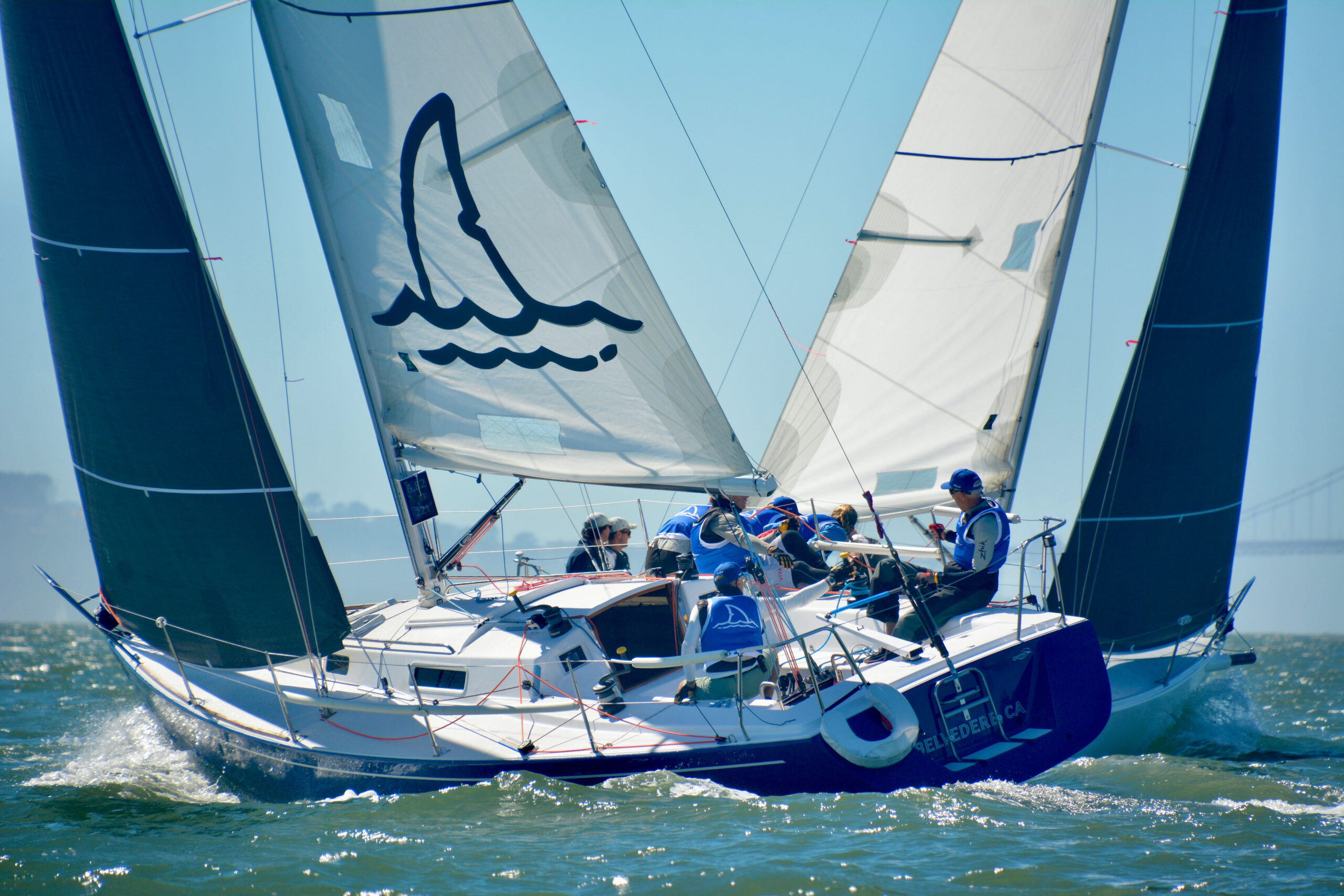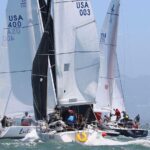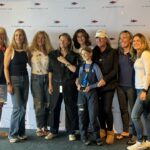|
|
|||||||||
Boat Speed and Handling Tips: 1. Flat is Fast. – It’s always better to dump the main in puffs to keep your boat on her “feet” than try to pinch into it. A combination of both can be effective as well but as a rule of thumb if your leeward stantion bases are ever in the water you too healed over. Solution is to sail with a looser leech and to play the main sheet rather that the traveler in big breeze and/or puffy conditions. 2. Jibing in big breeze. – We have found it helpful to pull vang on hard prior to jibing. This helps to tighten the leech on the main which in turn reduces the degrees the skipper needs to turn the boat to get the main to come across. After the jibe, remember to let the vang off back to previous spots, as a waiver I won’t take responsibility for broken booms#@$, but if you have the standard/legal amount of purchase on the vang this shouldn’t be an issue in big breeze. Try this when the breeze is strong, it’s very effective in combination with the “S” turn jibe. 3. Getting ready to start the next race after we finish the last. – This is the classics “do as we say not as we do”. I can not count how many times we have been caught eating sandwiches and cookies way away from the line with we realize we have 4 minutes to start. With the new starting system it is now important to start the set up for race 2 immediately after race 1. Only after we are ready to race will we get awarded with food. 4. Big picture tactics. – Making tactical decisions that back up the below strategies: Get a clean lane: Good clean lanes are not easy to get in big fleets. Fight for them and stay in them. The smaller the race course the more this rule oft thumb is applicable. When picking a lane, think not only about what it looks like at that moment but what it will look like in 3,5,8..minutes. 5. Minimize tacking: – These boats (J105’s) loose a chunk when you tack, especially in breeze and bump, Lee bowing a starboard tacker can equal two extra tacks, When deciding to waive a port tacker or force them to tack we mainly look at their lane to see if it’s a good one, considering both wind shifts and clean air.
Preparing the Rig for the onslaught of another season can take time but will pay in results. – This offseason I pulled the standing rigging for inspection after four years of hard San Francisco sailing and found it needed some attention. The paint had been weathered a bit and had lost its luster, the spreaders looked like wings that had just flown through an ice storm. The forstay was kinked at the upper section of the furler because the inside spacer had dropped and the aluminum was chafing the rod and peeling away. Both the forestay and the uppersection of the foil were replaced. All other points were in good working order. The mast, spreader and boom, were disassembled piece by piece, labeled, and prepared for a new paint job. I did some of the sanding prep but left most of the finishing for Art Puett and his crew at Nelson Marine, my long time trusted friends. The reassembly and tuning was something left to Glen Hansen and his crew at Hansen Rigging. We tuned to factory and Sail loft specs. A generous layer of McLube Sailkote on all surfaces. We ran the Jib halyard to starboard and the Main to port. This allows better upwind tension and pointing ability, since the lewmar and or spinnlock cleats slip so much we now can wrap each on a separate secondary winch and leave them tight for up wind adjustment. I upgraded to the Ronstan turnbuckle system for the Cap Shrouds and the D1s and left the D2s standard. These systems have been approved since 2001 and allow better reference when tuning. I haven’t touched it since Glen and crew placed the settings. Which are Caps at 41, D1s at 31, and D2s at hand tight. The forstay is about set in the middle of the minimum and maximum settings. There should be no doubt that constant inspection and maintenance are essential factors to consistent performance. Our aggressive Bay conditions will take their toll on equipment overtime. Overall though, I am satisfied with the endurance of the equipment and a bit surprised with its minimal wear and tear. Bella Rosa has 2 bullets this year and won the 2002 J Fest with a 1,3,3,4 total of 11 points. |
|||||||||
|
|
|||||||||
|
|
|||||||||
|
Have a Plan at the Start – Ian Charles, Sails Call Key takeaways:
ll to often, skippers and their crews don’t have a plan at the start. A combination of the stress at the start, the tight traffic and an overall confusion about where to start takes a lot of boats out of the race before it begins. Start with a plan that takes into account the answers to following questions: (1) which end of the line is favored (2) is the gain at the favored end going to be negated from adverse current to (3) if the favor is 10+ degrees, are you and your team prepared to carve out and protect your hole and position without fouling other boats in what is likely to be the popular end of the line and (4) are you better off 1/3 of the way up the line with clean air and speed? In building this plan, I suggest doing frequent wind checks and the simple math it takes to identify a favored end. If the line is square and it’s a question of boat speed at the start, try thinking 2/3rds the way up the leg and which side you want to be on. If you want to go left, discuss that with your team and get input that confirms or denies that call. More importantly, talk it over and understand why a decision is being made. Remember, the top boats in the fleet are consistently on top because they made good decisions on the course. That said, I find that many boats at the start are more concerned with enforcing leeward rights than building their boat speed. Gentlemen, the decision should be to get that boat moving rather than trying to plant yourself under another boat just because you can. Stuffing the boat to windward isn’t your objective (unless they are barging which is a big no-no); it’s getting off the line clean and with speed. We take timing runs at the point in the line where we would like to start so we know when to turn the boat in that direction. Timing is everything in starting and knowing where you want to start will help you triangulate speed, distance and time. Now understand that another element is required that most sailors don’t think about-an escape route. Where a skipper’s job becomes complicated is in the number of variables (time, speed, rights, distance, pressure, room, communication etc…) he/she must continuously calculate. When this challenge becomes too over whelming the “caught-in-the-headlights” factor sets in and there’s no gray matter left to think about an escape route. Simply put, as you approach a situation that isn’t setting up according to your plan, have your escape thought out so you get move to Plan B. For instance, if your hole is closing out at the Committee Boat, look for a hole down the line and get there rather than starting second or third row. Another thing I notice are boats that like to barge in and just sit on the line with no forward speed. Sure, you are on the line but (1) you are not sailing a Vanguard 15 and (2) by the time you pull the trigger to build speed you’ve been rolled to windward and leeward. Remember, these boats require time to get up to speed so hitting the line at full with pace, albeit ½ boat length off the line, outweighs planting yourself on the line with no speed. I’ve never seen a boat plant themselves on the line with no pace and take a bullet. You guys know who you are so don’t do that anymore! Sails Call was season champ in 1999 and runner up to Good Timin’ in 2001 by a single point. Sails Call has won numerous events and untold number of bullets. Ian Charles is the proud new father of a baby boy…..but is that any excuse not to be out there kicking our butts? |
|||||||||
|
|
|||||||||
|
Avoid the City Front Ping Pong – Phil Perkins, Good Timin’. When racing on the City Front in a flood tide, getting to the beach on the weather legs can be crucial. Just as crucial however is keeping your boat moving through the water. You can get in trouble if you lead into the beach on starboard tack and can’t cross the boats on your hip (or call for sea room when you get to the shore). When coming off the beach, it is sometimes tempting to lee bow the next starboard tack boat and lead them to the beach in the better tide. The problem with this tactic is that you have just tacked twice in a very short period and your boat has never gotten up to speed. Meanwhile, a boat that chose to duck the starboard tack boats and get a lane outside has tacked one less time when you meet again up thecourse. Quite often one less tack will outweigh the tidal advantage of being closest to the beach and will prevent you from feeling like at ping pong ball between the beach and a never ending line of starboard tackers. Good Timin won the Hospice Cup and leads the season series as of May 28, 2002. Good Timin’ won two races and won the regatta. Good Timin’ is also the fleet champion for the last two years. Sail Conservatively – Dean Dietrich, Blackhawk. Sounds boring, right? You’re amped up for the start, heart racing, andrenalin flowing, and you feel you can put your boat anywhere on the line. Too often this attitude has carried me around the race course, delaying spinnaker drops until the last moment and other similiar “sins”, none of which are appreciated by my crew. Sailing is a percentage game where you have to evaluate the risk/reward ratio of your moves, and in all but a few cases, the correct evaluation is to do the conservative thing. For example, approaching the windward mark on port (outside the two boat-length circle, of course) you have to decide whether to duck a starboard tacker or tack under him, hoping you are on the layline. Nine times out of ten, you are better ducking. Consider the risk/reward. Sure, if you make it, you round in front, but if you don’t, you have nowhere to go except to jibe around and crawl back to the layline after the the rest of the fleet has passed. Tres ugly. Or consider starting at the favored pin end. You and the rest of the fleet are going to be vying for very small real estate and there will only be one or two winners. Better to sail higher up the line with clear air. I find myself asking in a situation: what is the conservative thing to do and unless I feel strongly otherwise, that’s the course I follow. You may not get as many bullets, but you will avoid those double digit finishes that take you out of a regatta and demoralize you and the crew.
Blackhawk has won two races this year, the Ocean race and race 3 of the Hospice Cup. |
|||||||||
|
|
|||||||||
|
Duck the Boats on the Starboard Layline – Several times during Race 3 of the Jfest, we faced the classic Hobbesian choice near the weather mark: do I leebow that guy on the starboard layline, or take my lumps and duck him? A number of considerations go into this decision. Will the flood set us into the mark? How many boats will I have to duck? Am I tacking within 2 boatlengths of the mark? In most cases, and especially on the first beat, the answer is almost always to duck. We did this more than once in Race 3, and benefited from the conservative decisionmaking. While it delayed some passing opportunities, patience kept us in the hunt, well-positioned for the next leg and able to capitalize on future opportunities. Winning races is often about avoiding mistakes – especially on the Bay — and jamming it into a tight weather mark is one of the most common ways to take yourself out of a race. Nantucket Sleighride has 1 bullet and is currently in 3d place in the season standings. |
|||||||||
|
|
|||||||||
|
Keeping track of things on the leeward leg – Dave Wilson, Good Timin – Since the natural tendency for the crew on a leeward leg is to look forward down the course, it can be very easy to forget to keep track of the wind coming up from behind. On our boat, the bowman is in charge of looking aft and telling the crew what’s going on with the wind. Since the helmsman is trying to keep the boat down in the puffs and up in the lulls (in concert with the spinnaker trimmer), it can be especially helpfull if there is advance notice of these wind changes. Another benefit is tracking both the wind lanes as they are chopped up from the multiple fleets, and any boats who might be attacking your position by trying to sail above your course and take your breeze. And since the inside position is crucial at the leeeward mark, its good to have someone keeping track of the other boats’ positions as you get closer to the mark. Additionally, any major changes to the wind, such as a front or a new westerly can also be followed by the crew member looking aft.Most of us wouldn’t consider driving a car without a rear view mirror, so it makes sense to keep tabs on what’s going on behind you on the race Good Timin has 2 bullets this year and is the defending season champion for the past two years 2000 and 2001. |
|||||||||
Winner’s Tips from 2006
March 26, 2006
Resources
 San Francisco J/105 Fleet #1
San Francisco J/105 Fleet #1



